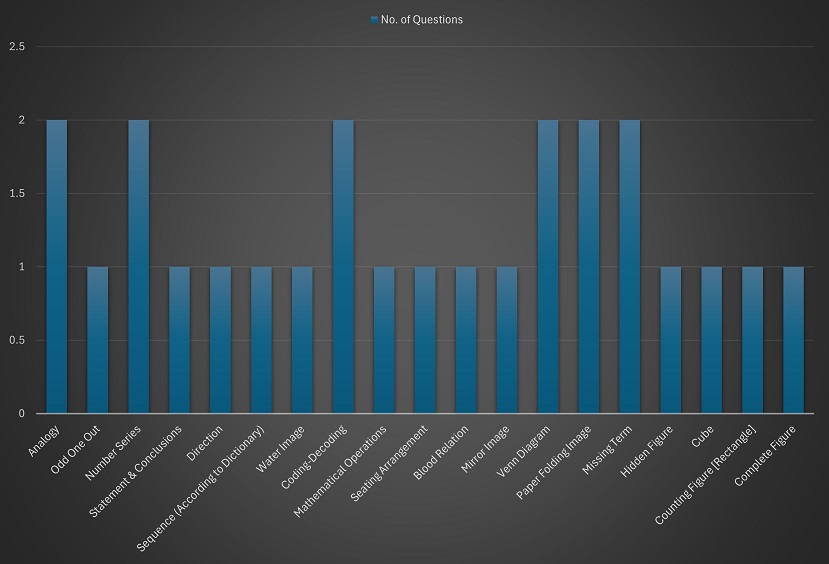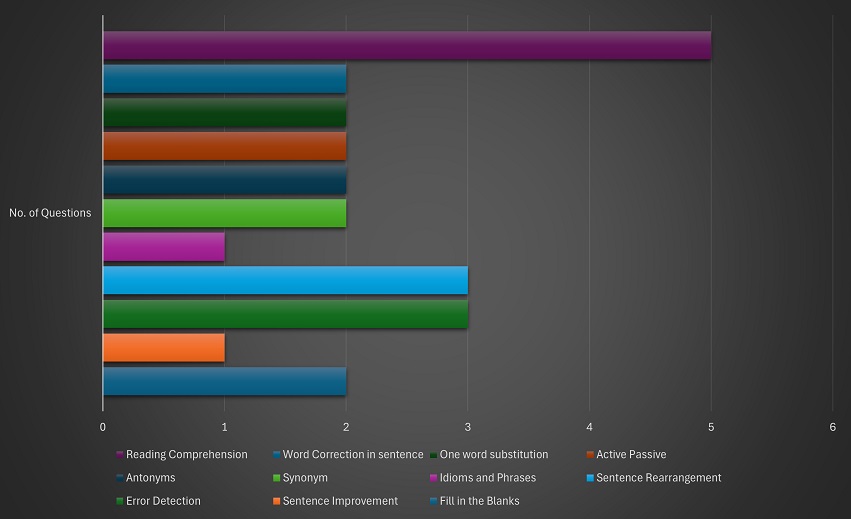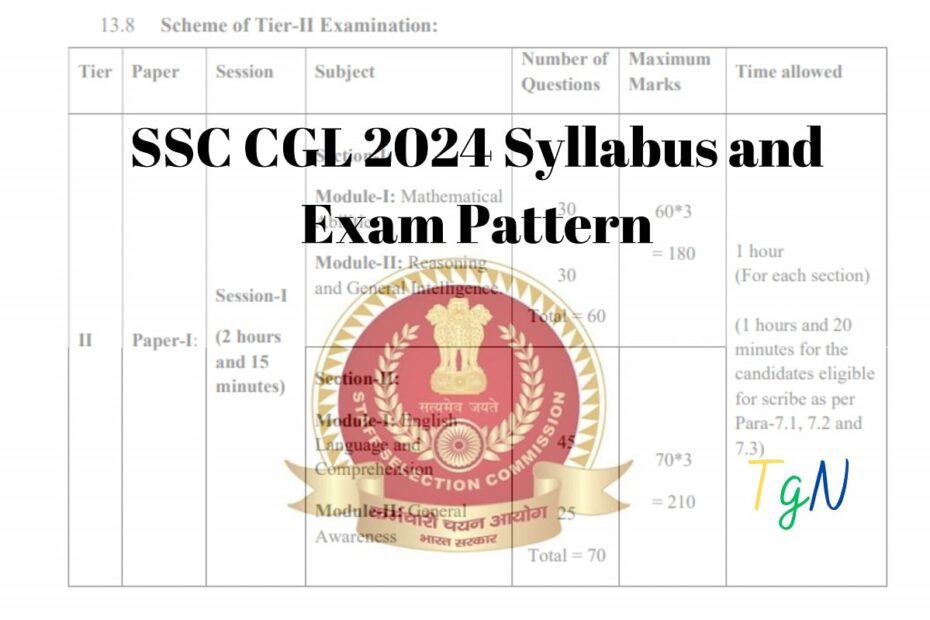When the official announcement of the SSC CGL 2024 exam is released, the SSC can also make any modifications to the exam format and curriculum known. In September and October of 2024, the SSC CGL 2024 Tier-1 Exam is expected to take place. Candidates must review the most recent SSC CGL curriculum and exam pattern to increase their chances of passing the exam. Effective exam preparation requires a basic understanding of the SSC CGL 2024 Syllabus and exam pattern for Tier-I and Tier-II exams. Let’s examine the most recent pattern of the SSC CGL 2024 Syllabus for Tier I and II tests.
Contents:
- SSC CGL 2024 Syllabus for Tier 1 Exam
- SSC CGL 2024 Syllabus for Tier 2
- SSC CGL Tier 2 PAPER 2 (Statistics)
- SSC CGL Tier 2 Paper 3(General Studies-Finance and Economics)
SSC CGL 2024 Exam:
Before beginning any exam preparation, applicants should familiarize themselves with the full and exact exam pattern as well as the comprehensive SSC CGL 2024 Syllabus to devise a foolproof plan for achieving high exam scores. This article has covered the SSC CGL 2024 syllabus and exam format for each SSC CGL Phase. A two-tier recruitment process will be used by the Staff Selection Commission to choose candidates for Combined Graduate Level positions. The SSC CGL Exam is administered in the following manner at all stages:
| Tier | Type | Mode |
|---|---|---|
| Tier – I | Objective Multiple Choice | Computer-Based (online) |
| Tier – II (Paper I, II, III) | Paper I (Compulsory for all posts),Paper-II for candidates who apply for the posts of Junior Statistical Officer (JSO) in the Ministry of Statistics and Programme Implementation and Paper III for candidates who apply for the posts of Assistant Audit Officer/ Assistant Accounts Officer. Objective Type, Multiple choice questions, except for Module-II of Section-III of Paper-I | Computer-Based (online) |
SSC CGL 2024 Syllabus for Tier 1 Exam:
The subject-specific SSC CGL 2024 Syllabus for the Tier-1 exam, which is divided into four sections: quantitative aptitude, general intelligence and reasoning, English language, and general awareness, must be known by students before they start studying for the exam. Here is a full discussion of the SSC CGL 2024 Syllabus for Tier-1 Exam.
SSC CGL Tier 1 Exam Pattern:
According to the Tier 1 Exam the SSC CGL 2024 syllabus, there will be four sections, each comprising 25 questions. The time allotted for completing the Tier 1 Exam is 60 minutes, and there is a penalty of 0.50 marks for each incorrect answer. Try our free SSC CGL mocktest. The SSC CGL Tier 1 Exam Pattern details are here:
| S No. | Sections | No. of Questions | Total Marks | Time Allotted |
|---|---|---|---|---|
| 1. | General Intelligence and Reasoning | 25 | 50 | A cumulative time of 60 minutes(1 hour) |
| 2. | General Awareness | 25 | 50 | |
| 3. | Quantitative Aptitude | 25 | 50 | |
| 4. | English Comprehension | 25 | 50 | |
| Total | 100 | 200 | ||
SSC CGL 2024 Syllabus for Quantitative Aptitude:
In the SSC CGL Tier-1 Examination, the Quantitative Aptitude section assesses the candidate’s proficiency in utilizing numbers and demonstrating a sound understanding of numerical concepts. This segment is consistent across Tier-1 and Tier-2, and certain topics recur. Therefore, thorough preparation for these topics is crucial, as it will not only enhance performance in Tier-1 but also streamline preparation for subsequent stages. The designated topics for the SSC CGL Quantitative Aptitude, outlined by the commission, include:

- Computation of whole numbers
- Decimals
- Fractions
- Relationships between numbers
- Profit and Loss
- Discount
- Partnership Business
- Mixture and Alligation
- Time and distance
- Time & Work
- Percentage
- Ratio & Proportion
- Square roots
- Averages
- Interest
- Basic algebraic identities of School Algebra & Elementary surds
- Graphs of Linear Equations
- Triangle and its various kinds of centres
- Congruence and similarity of triangles
- Circle and its chords, tangents, angles subtended by chords of a circle, common tangents to two or more circles
- Triangle
- Quadrilaterals
- Regular Polygons
- Right Prism
- Right Circular Cone
- Right Circular Cylinder
- Sphere
- Heights and Distances
- Histogram
- Frequency polygon
- Bar diagram & Pie chart
- Hemispheres
- Rectangular Parallelepiped
- Regular Right Pyramid with triangular or square base
- Trigonometric ratio
- Degree and Radian Measures
- Standard Identities
- Complementary angles
SSC CGL 2024 Syllabus for General Intelligence and Reasoning:
Both verbal and non-verbal reasoning are covered in the SSC CGL 2024 syllabus. There are twenty-five questions total with fifty marks in this section. Test your preparation with the SSC CGL free practice test created by us.

- Analogies
- Similarities and differences
- Space visualization
- Spatial orientation
- Problem-solving
- Analysis
- Judgment
- Blood Relations
- Decision making
- Visual memory
- Discrimination
- Observation
- Relationship concepts
- Arithmetical reasoning
- Figural classification
- Arithmetic number series
- Non-verbal series
- Coding and decoding
- Statement conclusion
- Syllogistic reasoning
SSC CGL 2024 Syllabus for the English Language:
The SSC CGL 2024 Syllabus for Tier 1 English Language will consist of 25 questions, amounting to a total of 50 marks. Among all the segments in the Tier 1 examination, this particular section will exclusively focus on English.

- Idioms and Phrases
- One word Substitution
- Sentence Correction
- Error Spotting
- Fill in the Blanks
- Spellings Correction
- Reading Comprehension
- Synonyms-Antonyms
- Active Passive
- Sentence Rearrangement
- Sentence Improvement
- Cloze test
SSC CGL 2024 Syllabus for General Awareness:
Mastering the SSC CGL 2024 Syllabus for General Awareness is not an overnight task. However, from an examination perspective, consistent and focused effort can enable a candidate to excel in a comparatively shorter duration than is required for Quantitative Aptitude.

- India and its neighbouring countries especially pertaining to History, Culture, Geography, Economic Scene, General Policy & Scientific Research
- Science
- Current Affairs
- Books and Authors
- Sports
- Important Schemes
- Important Days
- Portfolio
- People in News
- Static GK
SSC CGL 2024 Syllabus for Tier 2
Following the completion of the initial examination, preparations must be made for the Tier-2 Exam of the SSC CGL 2024. The Main Exam will be administered online and comprises objective multiple-choice questions, except for Module II (Data Entry Speed Test) in Section III of Paper I.
SSC CGL Tier 2 Exam Pattern:
SSC CGL Tier 2 paper-I will be conducted in two sessions – Session I & Session II, on the same day and is compulsory for all candidates who qualify in Paper 1. Section I, Section II, and Module I of Section III will all be conducted during Session I. Module II of Section III will be conducted during Session II. The candidates must meet the requirements for each section of Paper I.
| SSC CGL Tier 2 Paper 1 | |||||
| Sections | Module | Subject | No. of Questions | Marks | Weightage |
| Section I | Module-I | Mathematical Abilities | 30 | 60*3 = 180 | 23% |
| Module-II | Reasoning and General Intelligence | 30 | 23% | ||
| Section II | Module-I | English Language and Comprehension | 45 | 70*3 = 210 | 35% |
| Module-II | General Awareness | 25 | 19% | ||
| Section III | Module-I | Computer Knowledge Test | 20 | 20*3 = 60 | Qualifying |
| Module-II | Data Entry Speed Test | One Data Entry Task | Qualifying | ||
| SSC CGL Tier 2 Paper 2 & 3 | |||||
| Paper | Section | No. of question | Maximum Marks | Duration | |
| Paper II | Statistics | 100 | 200 | 2 hours | |
| Paper III | General Studies (Finance and Economics) | 100 | 200 | 2 hours | |
SSC CGL 2024 Syllabus for Tier 2 Paper 1 Section 1 Module-I (Mathematical Abilities):
The primary emphasis of this segment is to assess the candidate’s proficiency in utilizing numbers appropriately and their numerical acumen. While this section is also included in the Tier-1 Exam, the questions are structured differently, and their complexity is slightly more moderate compared to the first stage. Therefore, candidates should intensify their preparation by focusing on the topics outlined below
| Topics | Sub-topics |
|---|---|
| Number Systems | Computation of Whole Number Decimal and Fractions Relationship between numbers |
| Fundamental arithmetical operations | Percentages Ratio and Proportion Square roots Averages Interest (Simple and Compound) Profit and Loss Discount Partnership Business Mixture and Alligation Time and distance Time and work |
| Algebra | Basic algebraic identities of School Algebra and Elementary surds (simple problems) Graphs of Linear Equations |
| Geometry | Similarity with elementary geometric figures and facts: Triangle and its various kinds of centres Congruence and similarity of triangles Circle and its chords, tangents, angles subtended by chords of a circle, common tangents to two or more circles. |
| Mensuration | Triangle Quadrilaterals Regular Polygons Circle Right Prism Right Circular Cone Right Circular Cylinder Sphere Hemispheres Rectangular Parallelepiped Regular Right Pyramid with triangular or square Base. |
| Trigonometry | Trigonometry Trigonometric ratios Complementary angles Height and distances (simple problems only) Standard Identities |
| Statistics and probability | Use of Tables and Graphs: Histogram, Frequency polygon, Bar-diagram, Pie-chart Measures of central tendency: mean, median, mode, standard deviation Calculation of simple probabilities |
SSC CGL 2024 Syllabus for Tier 2 Paper 1 Section 1 Module-II (Reasoning and General Intelligence):
Questions of both verbal and non-verbal types. These will include questions on
- Semantic Analogy
- Symbolic operations, Symbolic/ Number Analogy, Trends
- Figural Analogy
- Space Orientation
- Semantic Classification
- Venn Diagrams
- Symbolic/ Number
- Classification
- Drawing inferences
- Figural Classification
- Punched hole/ pattern-folding & unfolding
- Semantic Series
- Figural Pattern folding and completion
- Number Series
- Embedded figures
- Figural Series
- Critical Thinking
- Problem-Solving
- Emotional Intelligence
- Word Building
- Social Intelligence
- Coding and de-coding
- Numerical operations
SSC CGL 2024 Syllabus for Tier 2 Paper 1 Section 2 Module-I (English Language And Comprehension):
The SSC CGL 2024 Syllabus for Tier-2 section in question will serve as the basis for the English language proficiency test. To do well in this Tier-2 Exam section, you must have a basic understanding of the English language. The purpose of the reading comprehension syllabus is to assess candidates’ prompt responses to various scenarios; it is not a specific syllabus that is where our SSC CGL English mock test comes as a savior.
- Vocabulary
- English Grammar
- Sentence structure
- Spot the Error
- Fill in the Blanks,
- Synonyms/Homonyms
- Antonyms
- Spellings/ Detecting misspelt words
- Idioms & Phrases
- One word substitution
- Improvement of Sentences,
- Active/ Passive Voice of Verbs
- Conversion into Direct/ Indirect narration
- Shuffling of Sentence parts
- Shuffling of Sentences in a passage,
- Cloze Passage
- Comprehension Passage
SSC CGL 2024 Syllabus for Tier 2 Paper 1 Section 2 Module II (General Awareness):
The questions aim to evaluate candidates’ awareness of the surrounding environment and its practical implications for society. They are formulated to assess knowledge of current events and aspects of everyday observation and experience with a scientific perspective, aligning with what is expected of an educated individual.
- India and its neighbouring countries especially pertaining to History, Culture, Geography, Economic Scene, General Policy & Scientific Research
- Science
- Current Affairs
- Books and Authors
- Sports
- Important Schemes
- Important Days & Dates
- Portfolio
- People in News
SSC CGL 2024 Syllabus for Tier 2 Paper 1 Section 3 Module I (Computer Proficiency):
| Topics | Sub-Topics |
|---|---|
| Computer Basics | Organization of a computer Central Processing Unit (CPU) Input/ output devices Computer memory Memory organization Back-up devices PORTs Windows Explorer Keyboard shortcuts |
| Software | Windows Operating system including basics of Microsoft Office like MS Word, MS Excel, PowerPoint etc |
| Working with the Internet and e-mails | Web Browsing & Searching, Downloading & Uploading, Managing an E-mail Account, e-Banking |
| Basics of networking and cyber security | Networking devices and protocols, Network and information security threats (like hacking, viruses, worms, Trojans etc.) and preventive measures |
SSC CGL 2024 Syllabus for Tier 2 Paper 2 (Statistics):
This may be a challenging and confusing section for some candidates. To score well in this section as well, the basic advice is to make sure the concepts are understood. Repeatedly reviewing the concepts will help. The following describes the SSC CGL 2024 Syllabus for Tier-2 Statistics:
| Subject | Topics |
|---|---|
| 1. Collection, Classification and Presentation of Statistical Data | Primary and Secondary data, Methods of data collection; Tabulation of data; Graphs and charts; Frequency distributions; and Diagrammatic presentation of frequency distributions. |
| 2. Measures of Central Tendency | Common measures of central tendency – mean median and mode; Partition values- quartiles, deciles, percentiles. |
| 3. Measures of Dispersion- Common measures of Dispersion | Range, quartile deviations, mean deviation and standard deviation; Measures of relative dispersion. |
| 4. Moments, Skewness and Kurtosis | Different types of moments and their relationship; the meaning of skewness and kurtosis; different measures of skewness and kurtosis. |
| 5. Correlation and Regression | Scatter diagram; simple correlation coefficient; simple regression lines; Spearman’s rank correlation; Measures of association of attributes; Multiple regression; Multiple and partial correlation (For three variables only). |
| 6. Probability Theory | Meaning of probability; Different definitions of probability; Conditional probability; Compound probability; Independent events; Bayes‟ theorem. |
| 7. Random Variable and Probability Distributions | Random variable; Probability functions; Expectation and Variance of a random variable; Higher moments of a random variable; Binomial, Poisson, Normal and Exponential distributions; Joint distribution of two random variables (discrete). |
| 8. Sampling Theory | Concept of population and sample; Parameter and statistic, Sampling and non-sampling errors; Probability and nonprobability sampling techniques (simple random sampling, stratified sampling, multistage sampling, multiphase sampling, cluster sampling, systematic sampling, purposive sampling, convenience sampling and quota sampling); Sampling distribution (statement only); Sample size decisions. |
| 9. Statistical Inference | Point estimation and interval estimation, Properties of a good estimator, Methods of estimation (Moment’s method, Maximum likelihood method, least squares method), Testing of hypothesis, Basic concept of testing, small sample and large sample tests, Tests based on Z, t, Chi-square and F statistic, Confidence intervals. |
| 10. Analysis of Variance | Analysis of one-way classified data and two-way classified data. |
| 11. Time Series Analysis | Components of time series, Determination of trend component by different methods, Measurement of seasonal variation by different methods. |
| 12. Index Numbers | Meaning of Index Numbers, Problems in the construction of index numbers, Types of index numbers, Different formulae, Base shifting and splicing of index numbers, Cost of living Index Numbers, and Uses of Index Numbers. |
SSC CGL 2024 Syllabus for Tier 2 Paper 3 (General Studies-Finance and Economics)
This segment of the SSC CGL 2024 Syllabus for Tier 2 is categorized into two parts: Finance & Accounts and Economics & Governance. The specific sub-topics for each are outlined as follows –
| Part | Subject | Topics |
|---|---|---|
| Part A: Finance and Accounts-(80 marks) | Financial Accounting | Nature and scope Limitations of Financial Accounting Basic Concepts and Conventions Generally Accepted Accounting Principles |
| Basic concepts of accounting | Single and double-entry Books of Original Entry Bank Reconciliation Journal, ledgers Trial Balance Rectification of Errors Manufacturing Trading Profit & Loss Appropriation Accounts Balance Sheet Distinction between Capital and Revenue Expenditure Depreciation Accounting Valuation of Inventories Non-profit organisation’s Accounts Receipts and Payments and Income & Expenditure Accounts Bills of Exchange Self-Balancing Ledgers | |
| Part B: Economics and Governance-(120 marks) | Comptroller & Auditor General of India- Constitutional provisions, Role and responsibility | |
| Finance Commission-Role and functions | ||
| Basic Concept of Economics and Introduction to Micro Economics | Definition Scope and Nature of Economics Methods of economic study Central problems of an economy Production possibilities curve | |
| Theory of Demand and Supply | Meaning and determinants of demand Law of demand and Elasticity of demand Price Income and cross-elasticity Theory of consumer behaviour Marshallian approach and Indifference curve approach Meaning and determinants of supply Law of supply The elasticity of Supply | |
| Theory of Production and Cost | Meaning and Factors of Production Laws of production- Law of variable proportions and Laws of returns to scale. | |
| Forms of Market and price determination in different markets | Various forms of markets-Perfect Competition Monopoly Monopolistic Competition Oligopoly Price determination in these markets. | |
| Indian Economy | Nature of the Indian Economy Role of different sectors, Role of Agriculture, Industry and Services problems and growth. National Income of India- Concepts of national income, Different methods of measuring national income. Population size, rate of growth and its implication on economic growth. Poverty and unemployment- Absolute and relative poverty, types, causes and incidence of unemployment. Infrastructure-Energy, Transportation, Communication. | |
| Economic Reforms in India | Economic reforms since 1991 Liberalisation Privatisation Globalisation Disinvestment | |
| Money and Banking | Monetary/ Fiscal policy- Role and functions of Reserve Bank of India; functions of commercial Banks/RRB/Payment Banks. Budget and Fiscal deficits and Balance of payments. Fiscal Responsibility and Budget Management Act, 2003. | |
| Role of Information Technology in Governance | ||
You can read the official notification from the SSC CGL 2024 syllabus pdf.
